By Michael Vallier, Product Manager
ABB Low Voltage Drives,
ABB Automation Products
Efficient management of the energy consumed by motors was always important. Today, however, this issue has become vital as the world wrestles with the supply and demand of precious resources. Thus, integrators, OEMs, panel builders, and users are looking for ways to use energy as efficiently as possible.
It is well known that the precise control of motors is one technique. Some engineers, though, are turning to multidrive systems to boost energy efficiency even higher. Since drives are available in both multidrive and single drive configurations, it is useful to define the difference, and profile the benefits that new generations of multidrives can provide.
Single drives
Adjustable speed drives are used in any application in which there is mechanical equipment powered by motors. The drives provide precise electrical motor control so that motor speeds can be maintained or ramped up and down depending on the action needed. Such control uses only the energy required, rather than having a motor run at constant (fixed) speed and using excess energy.
Because motors consume a majority of the energy produced, controlling the amount consumed based on load demands is the way to go. You can realize 25 to 70% energy savings through the use of motor controllers. Despite these benefits, though, the majority of motors continue to operate without drives.
Several single industrial drives are flexible ac drives that can be adapted to meet the precise needs of a single-motor application. These units convert ac power to dc, and then invert the dc back to an ac output to a motor. Such drives cover a wide, full range of powers and voltages. Single industrial drives also feature a range of built-in options as standard equipment. They can be installed for most applications right out of the box; and they also can be ordered and manufactured as a custom unit for a particular application.
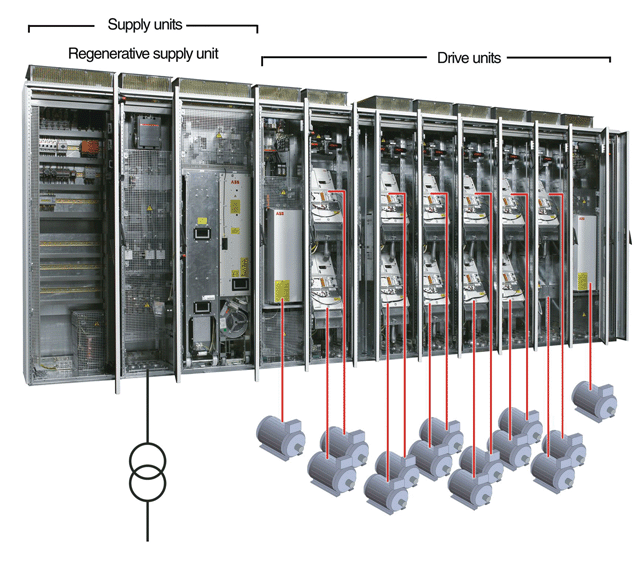
Multidrives, such as this one from ABB, are made from several components.
Multidrives
A multidrive is built from industrial drive modules that are connected to a common dc bus bar. This bus bar supplies the drive modules with dc power and each module then inverts the dc to ac and powers an individual motor. The dc power is derived from a single supply unit (rectifier) that is built into the front end of the same multidrive configuration.
This configuration simplifies the total installation and provides many benefits:
• savings in cabling
• reduced line currents and simpler braking arrangements
• energy distribution over the common dc bus bar, which can be used for motor-to-motor braking without the need for a braking chopper or a regenerative supply unit
• reduced component counts
• increased reliability
• space savings
• the elimination of a separate Motor Control Center (MCC).
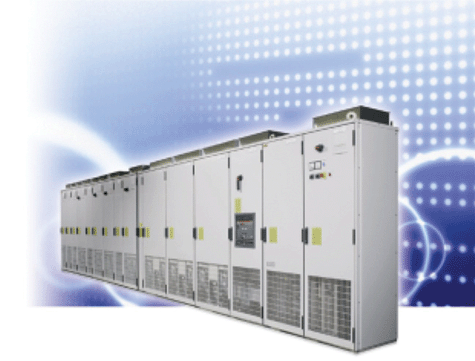
A
multidrive is built from industrial drive modules connected to a common
dc bus bar that supplies the drive modules with dc power. Each module
inverts the dc to ac and powers an individual motor.
Application
In general terms, multidrives can be used whenever several drives and motors form part of a single or integrated mechanical process. The common supply of the multidrive lets you implement safety and control functions over all parts, and enables the close coordination of individual drive motors. For example, a paper machine has many motors that must be individually controlled in a system. Multidrives offer fast communication of torque and speed signals between the drives to control the tension in the paper web.
Multidrives also can be used where the shafts of individual drive motors are not tightly coupled; for example, in processes where each drive module can be programmed with a speed profile to reduce the overall use of energy. These two examples demonstrate the range of applications where multidrives offer benefits over other types of drive constructions.
Modular configuration of multidrives provides control of multiple motors across a 1 to 7000 hp power range, from 380 to 600 (690) Vac. A single rectifier unit can be combined with several inverter units connected in parallel, to provide output current required by any given application. Additional benefits include:
• Encoderless motor operation – Some multidrives offer dynamic-response through proprietary motor control algorithms enabling many applications to be run without encoder feedback.
• Flexibility – In some multidrives, only four types of diode rectifiers invert ac three-phase input power to the common dc bus bar across the drive’s power range.
• Compact design – Improvements in technology and power components have reduced the total footprint of some multidrives by 50%. This frees up significant wall, panel, and floor space.
• Range of options – I/O extensions, field buses and a pulse encoder module can all fit inside the inverters.
• Adaptive programming extends the programmable I/O and extensive parameter selections built into the multidrives. This feature can access parameter selections for flexibility in precise control of all individual motors; like a mini PLC built in.
• Reduced installation costs – Because the modular configuration uses a common dc bus, the cabling input power required is a single three-phase ac connection. Further, the cabling is wired to the rectifier module through a plug-in connector, which then powers the entire common dc line-up. And the plug-in connectors for the inverters are wired to the motor terminals. Both the rectifiers and the inverters are rolled in on their wheels and seated into the connectors.
• Redundancy – these systems also offer common spare parts and the ability to keep running at reduced load.
Thus, with the line up of features, as well as the potential energy savings and efficient control, multidrives may suit your application.
ABB, Automation Products, Low Voltage Drives
www.abb.us/drives
Overview of the construction
An ABB multidrive is built from several sections. The key units within these systems include:
The inverters have built-in capacitors for smoothing the voltage of dc bus bars.
Diode Supply Units (DSU) automatically adapt to 6- or 12-pulse operation. During start-up, they deploy a built-in control system that automatically charges the inverters’ capacitor banks.
IGBT Supply Units (ISU) used in regenerative drive systems and applications requiring low harmonics convert three-phase ac voltage to dc voltage.
Thyristor Supply Units (TSU) in a regenerative drive can regenerate power back to the mains.
In resistor braking, whenever the dc bus voltage of a frequency converter exceeds a certain limit, a braking chopper connects the circuit to a braking resistor.
Optional control units are equipped with communication interfaces, power supplies, and other devices for automation equipment.
:: Design World ::
Filed Under: Drives (servo) + amplifiers

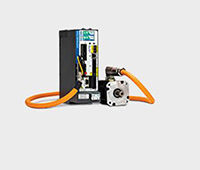

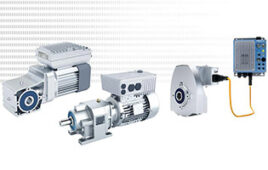
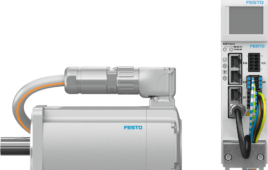
Tell Us What You Think!